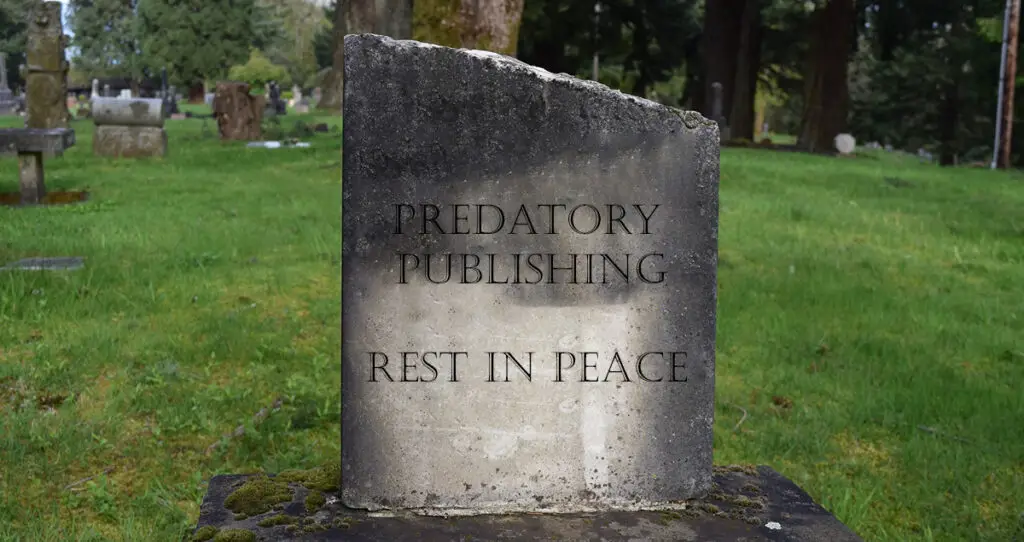Introduction
There is no single definition of predatory publishing that has been widely adopted.
The term predatory publishing was never used in two of the most high profile examples, where this issue is covered.
It is for these reasons that we believe that we should stop using the term “predatory publishing“.
Scholars should take more responsibility for deciding where to submit their papers, rather than relying on lists which classify journals as predatory, or not. These lists are not reliable.
Of course, we also need to address why our web site is called predatory-publishing.com as that, in itself, suggests that we believe that there are such things as predatory publishers. We’ll explain the reason why our domain has this name in another article, which we’ll link to once it is published.
When was the term first used?
The term predatory publishing has been around for over ten years. We consider its origins as 2010, in a Jeffrey Beall paper, in which he first referred to open access publishers acting in a predatory way. Others might trace the first discussions to a blog post by Eysenbach in 2008 or a 2010 paper by Sanderson. Whatever its origins, we now feel that it has served its purpose and it is time to put the term to rest.
Why should we retire the term?
We argue that it is no longer appropriate to use the term “predatory publishing” (and by extension “predatory publisher” and “predatory journal“). Why? There is no generally agreed definition of predatory publishing, even though many (many, many) definitions exist, both in the scientific and mainstream media. The definitions do largely agree with each other, in broad terms, but they are not interchangeable.
Most people want a definitive, binary classification stating whether a given journal is predatory, or not. This is what Beall’s list did, until it was taken down in 2017. The list was useful, as it did have a binary classification (if it was on the list it was predatory), and it served many people, for many years. Yet it was not without controversy, including his methodology not being transparent and Beall was the only person deciding if a journal was predatory or not.
If the community could agree on a single definition that would be great and we could even accept a few false positives-negatives, as we feel that we could live with that, as we would at least be looking at the journals through the same lens, via one definition. However, could we ever agree on just one definition? We think not.
If we accept (and you might not accept this) that we will never agree on a single definition of predatory publishing then, we feel, that we should stop using the term.
Two high profile examples
Jeffrey Beall and OMICS are, arguably, the most well-known person/publisher when we make reference to the term predatory publishing. We look at when (if) they used the term predatory publishing (spoiler alert – they did not).
Jeffrey Beall
Jeffrey Beall never used the term “predatory publishing” when he first used the term “predatory” in his seminal 2010 paper, “Predatory Open-Access Scholarly Publishers“. He did say “These publishers are predatory because …” and also said that he uses the term predatory with caution with respect to categorizing certain open access publishers with certain characteristics.
It is right that Beall is now credited with introducing the term “predatory publishing“, but we should be aware that he never used that precise term and never provided a definition in his seminal paper.
OMICS
“The most well known, proven predatory publisher is OMICS.“
We have used sentences such as this in our previous posts and in some of the articles we have published, but it is wrong. The OMICS court case never used the phrase “predatory publishing” (or variants). Rather, the court papers used the term “deceptive practises“. Therefore, it is not right to say that OMICS are a proven predatory publisher. We may interpret it as such, but this is not the term used in any of the court papers.
The more correct phrasing (but we are not lawyers) is to say that “OMICS were found to be using deceptive practises and were find USD $50.1 million as a result.” If you want to read more about the OMICS court case, take a look at these papers; Manley2019a, Manley 2019b, Dyer2019.
Others have called for the term to be retired
At least two other people have called for the term predatory publishing to be retired.
Rick Anderson, in a Scholarly Kitchen Article, said that the term predatory is an attention-grabbing term, it means different things to different people, and it is not helpfully descriptive. Some of the ways that the term predatory publishing could be interrupted include misrepresentation of board members and/or impact factors, sending spam emails, stealing content from other journals and hiding the fees until a paper is accepted. But these are only a few of the aspects that might be considered predatory and the more examples you add, the more debate these is and the larger the grey zone between predatory and legitimate journals grow.
Eriksson and Helgesson, in an article entitled “Time to stop talking about predatory journals“, said that it was time to stop using the term predatory journals. Hiding a wide range of scholarly misconduct, being used as a synonym for poor quality and the scholarly community being unable to classify a journal as predatory or not were some of the reasons given.
These calls go back almost ten years and, yet the term is still widely used. Perhaps, this is why it is so difficult to state, with certainty, whether a journal is predatory or not, as the journal will meet some criteria, from one definition, but avoid criteria, from other definitions – with the result being that it is almost impossible to definitely categorize a given journal. Perhaps we will never be able to, even if we had a widely agreed definition, that was consistently used. Perhaps, it is just too complex, and we should just give up and look for alternatives.
Like a few others before us, we believe that it is time that the term predatory publishing is retired.
What do we do instead?
Of course, those that seek fees to publish your articles with little, or no, peer review still exists but they are just one example of bad practices that fall under the umbrella of “unethical publishing.” Other examples of unethical publishing include selling authorships, manipulating citations, plagiarism, unacknowledged use of large language models, cloning journals, claiming impact factors which you are not entitled to use, setting up impact factors which are just used to persuade scholars that the journal is of good quality etc. Some of these would indicate that a journal/publisher is predatory (using the old terminology) but not all and, there are many missing, which brings us back to the old problem of trying to define predatory publishing.
Of course, we still have the problem of defining unethical publishing but, rather than doing that, when we use the term in the future, we will specify what we mean by that term, in the context of how we are using it. For example, if we are looking at a publisher that spends spam email, we will say that this is, in our view, is unethical. In the past, sending spam emails was one of the indicators of predatory publishing but not everybody listed that in their definition, so is it predatory publishing or not? However, we can argue that it is unethical, as long as we state that view and back it up with evidence.
Moreover, using the term unethical in a targeted way does not label the entire journal and perhaps, by extension, the publisher as predatory. We are just noting that one aspect of its operation is unethical. This seems fairer and we are being a lot more focused when we say that a journal is acting unethically.
When scholars are trying to identify a suitable journal, they should not have to know that a journal is predatory and that it meets with a whole range of issues that the given definition provides. Rather, if a scholar finds unethical behavior they need to decide whether that behavior is enough to persuade them to stop considering that journal as a potential outlet for their latest paper. Why does a journal have to meet a whole set of conditions, via the definition of predatory publishing, when just one example may suffice to stop it being considered. Once you reach your threshold, stop, and look for another journal.
So, there are no predatory journals
It is not currently possible to definitely classify a journal as predatory. We do not believe that this will ever be possible as there is no widely agreed definition, just many definitions which broadly say the same thing, but are slightly different from each other. These many definitions result in a huge grey area. Okay, there are some journals which are primarily driven by finance (the common denominator in predatory journals – but hard to find direct, undisputable evidence for), and others which are legitimate, but there are many which fall into a grey area, and so it is not clear.
Therefore, we have come to the conclusion that we should stop using the term predatory publishing (and variants).
Scholars, step up to the plate
Scholars have to take responsibility to decide whether to submit an article to a given journal. They should carry out their own due diligence and decide whether the journal is trustworthy. This decision must be evidence based and scholars should be able to use the evidence to decide if their selected journal is worthy of their paper. They should not rely on services that provide a binary classification, as these classifications will always be controversial.
Whether you submit to a given journal is multi-faceted. Are the aims and scope a good fit, is it open access (and can you pay the fees), do your peers publish in this journal, are the papers highly cited (if this is important to you), where is it indexed, what is its impact factor and quartile (if this is important to you), how many papers have been retracted from the journal, who is the editor-in-chief, are the members of the editorial board known within your community, has the journal been targeted by paper mills, what is its acceptance rate, how long does it take to reach a first decision, how do you contact the journal, does it send spam emails, does it carry our robust peer review, can you contact the editor-in-chief etc. etc.
Asking whether a journal is predatory subsumes many of the questions you might want to ask, but you do not need to know if a journal is predatory (and thus need to have the answer to so many questions), you just need to identify (or not) whether the journal acts in an unethical way, in just one (or a few areas) and you can make you decision based on that.
Call to action
- Scholars need to step up, carry out their own due diligence and make their own decisions whether to submit to a journal or not.
- Do not rely on binary lists to decide if a journal is predatory, or not. Any such list will be controversial.
- Look for unethical behavior in journals/publishers. Only you can decide if a journal has crossed some ethical line in the sand. Once you have found that a line has been crossed, stop and move into another journal.


